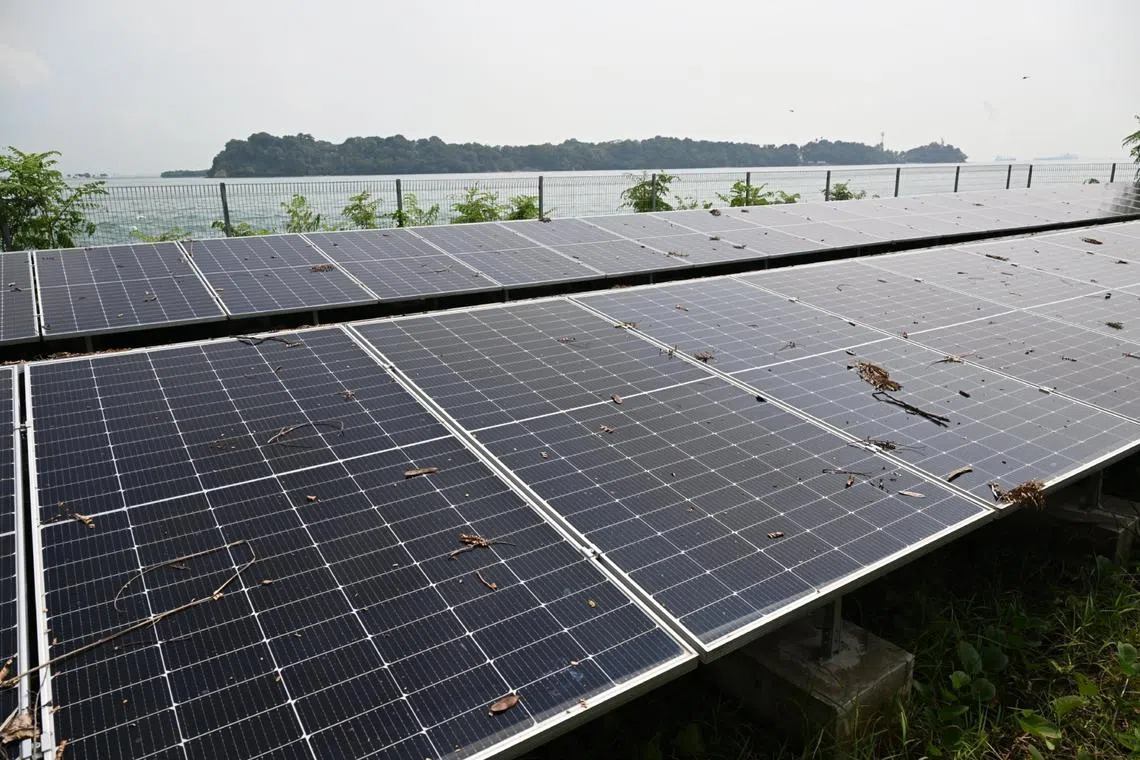Commentary
UN climate meets are not just all talk – they can affect policies, industries and jobs
Sign up now: Get ST's newsletters delivered to your inbox

Recent outcomes from the climate COPs have influenced national policies, changed industries and affected jobs worldwide, including in Singapore.
ST PHOTO: CHONG JUN LIANG
Follow topic:
SINGAPORE – It is easy to dismiss the annual UN climate conferences – the next one being COP29 in Baku, Azerbaijan, from Nov 11 to 22 – as talk shops, where many gather, much is discussed and little implemented, despite the announcements of headline targets.
But the multilateral negotiations at these events, though mired in jargon and sometimes glacial in progress, have real-world implications for many people.
Recent outcomes from the climate COPs have influenced national policies, changed industries and affected jobs worldwide, including in Singapore.
One of the clearest examples of this emerged after COP26 in Glasgow in 2021,
This means that nations do not just have to rely on domestic mitigation strategies, such as deploying solar panels within the country, to decarbonise. They can also cooperate – such as when one country buys carbon credits from another – to achieve this outcome.
According to the International Emissions Trading Association, a non-profit business group, international carbon market transactions under the Paris Agreement may surpass a value of US$100 billion (S$132 billion) per year by 2030.
Following that COP, Singapore went full steam ahead on its carbon credits sourcing journey, and has announced collaborations with more than 20 countries on this front.
This has cascading impacts on the economy as well, with the green economy, carbon services and trading sector identified as new “sustainable” engines for jobs and growth.
In April, the Sustainable Finance Jobs Transformation Map
The Jobs Transformation Map noted that the sustainable finance market in Asean is expected to total $4 trillion to $5 trillion in the next decade, with financial institutions playing a key role in the green transformation.
The report also anticipates that about 4,000 to 5,000 new sustainable finance-related jobs will be required over the next decade, in areas ranging from sustainability risk to sustainable strategy.
Similarly, Singapore has responded to the global call for countries to set net-zero by 2050 targets.
To help with this, the Republic is embarking on a slew of initiatives to curb emissions from its power sector, which makes up about 40 per cent of the country’s total emissions.
This includes importing renewable energy from its neighbours and exploring new technologies – such as carbon capture, hydrogen, even nuclear – to do so.
Again, these developments will have trickle-down impacts for society, as discussions will need to be had on whether energy costs will have to go up, the safety of new technologies such as nuclear, and so on.
Intractable differences
A major criticism of these events is that they have not succeeded in limiting the rate of increase in global surface temperature to 1.5 deg C above pre-industrial levels, a threshold outlined in the Paris Agreement.
Scientists say limiting warming to the 1.5 deg C threshold can help the world avert climate catastrophe.
Already, the world has warmed by about 1.3 deg C since pre-industrial times.
Impacts are already being felt. Through a field of research known as attribution studies, climate scientists have detected the fingerprints of climate change in a slew of weather disasters – including heavy rainfall in Nepal in September which killed 244 people, the heatwave across Asia in April and May, and Typhoon Gaemi that hit the Philippines in July, with winds and rain affecting millions.
These disasters will affect lives, livelihoods, jobs and infrastructure, and can disrupt supply chains worldwide.
In the face of these disasters, most people would agree that the world needs to take action to prevent impacts from escalating further.
So why have the climate conferences not helped to nudge greater action?
The solutions are less clear-cut, and countries grapple with a few perennial issues that are not so easy to resolve. They include who should take the most climate action.
Developing countries say developed countries need to take the lead, given that these industrialised nations grew their economies at the expense of polluting the atmosphere. They also argue that their economic progress should not be hindered.
But developed countries have countered that given the scale of the problem, developing countries also need to pull their weight.
Then there is the issue of who should pay for this green transition.
Many developing countries have set climate targets for themselves that are conditional on them receiving financial support to reduce emissions and prepare for climate impacts.
Earlier rounds of negotiations had indicated that developed countries are obliged to provide climate finance to developing countries.
But now, developed countries are arguing that the developed/developing divide may not be that relevant, given the economic progress of many developing countries, and are calling for the contributor base to be expanded.
The COPs force countries to come to the same table to discuss these thorny issues, allowing them to air their considerations, propose solutions and negotiate on an outcome that can help to bridge differences that seem intractable.
These negotiations can be a slow process, which is why getting an agreement on just one of these issues can take a few COPs to hammer out.
But such is the nature of a multilateral process, which facilitates the dialogue that will allow the desperately needed climate action to materialise.
It may be a lot of talk, but without these talks, it is likely that much less can be accomplished.
Pushing boundaries
When the Paris Agreement was adopted in 2015, media outlets trumpeted it as a historic moment. The landmark accord, reported The New York Times, “will, for the first time, commit nearly every country to lowering planet-warming greenhouse gas emissions to help stave off the most drastic effects of climate change”.
The Paris Agreement provides a mechanism that requires countries to set, every five years, domestic action plans that get progressively more ambitious.
The next round of climate targets – dubbed nationally determined contributions – is due in February 2025, and many think-tanks have said COP29 will be a pivotal moment in getting countries to set more ambitious climate targets that can translate into actionable national policies.
The conference in 2024 has been touted as a “finance COP”, where a new climate finance target – referring to the amount of money developing countries will receive to help them implement climate action – is expected to be adopted.
As the US-based World Resources Institute noted on its website: “Getting a more ambitious goal will be essential to helping vulnerable countries adopt clean energy and other low-carbon solutions and build resilience to worsening climate impacts.
“Indeed, many developing countries cannot fulfil or strengthen their climate pledges without it.”
As COP29 edges closer, much will be discussed about what a “successful COP” will look like. Success will also look different to different parties.
Trying to evaluate the success or failure of each climate conference would be akin to trying to watch a tree grow. Progress can be slow, even incremental, but that does not mean these events have no bearing on climate action.
Tackling climate change is a tragedy of the commons. Each country acting in its own interest will not move the needle in tackling the climate crisis.
But reaching a global consensus on climate action – with so many interlinked issues of finance, justice, historical responsibility and equity – will not be easy.
The climate conferences serve to untangle some of these knotty issues, so countries will be more compelled to move.
One example is the creation of a loss and damage fund at COP27, the climate conference in Sharm El-Sheikh, Egypt, in 2022.
The fund aims to provide financial assistance to nations most vulnerable and impacted by the effects of climate change, and was hotly contested by developed countries for decades. This was mainly due to concerns that compensating for losses and damage caused by climate impacts will be an admission of legal liability, triggering litigation and compensation claims on a major scale.
So the fund’s creation was the culmination of decades of pressure from climate-vulnerable developing countries through a multilateral process. At COP28, some countries contributed to the fund, including Germany (US$100 million), Japan (US$10 million) and the US (US$17.5 million).
Again, criticisms will be levelled against whether these pledges are enough, and whether the speed of change is quick enough. These are valid points, but should not undermine the significance of these events.
Developments at the conference are still important to watch, given how the outcomes of these conferences could have implications for societies, industries and individuals.


